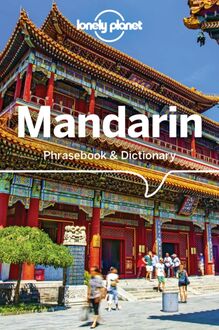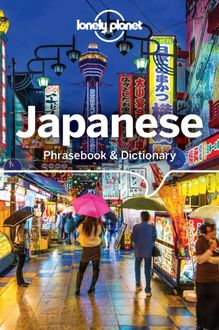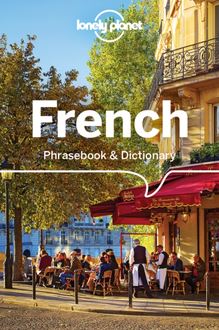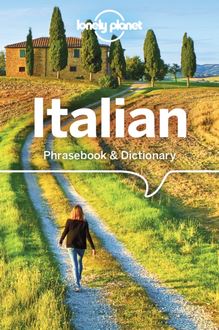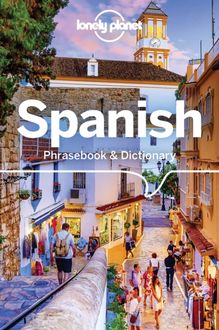-
 Univers
Univers
-
 Ebooks
Ebooks
-
 Livres audio
Livres audio
-
 Presse
Presse
-
 Podcasts
Podcasts
-
 BD
BD
-
 Documents
Documents
-
- Cours
- Révisions
- Ressources pédagogiques
- Sciences de l’éducation
- Manuels scolaires
- Langues
- Travaux de classe
- Annales de BEP
- Etudes supérieures
- Maternelle et primaire
- Fiches de lecture
- Orientation scolaire
- Méthodologie
- Corrigés de devoir
- Annales d’examens et concours
- Annales du bac
- Annales du brevet
- Rapports de stage
La lecture à portée de main
Vous pourrez modifier la taille du texte de cet ouvrage
Découvre YouScribe en t'inscrivant gratuitement
Je m'inscrisLonely Planet Mandarin Phrasebook & Dictionary with Audio , livre ebook
Découvre YouScribe en t'inscrivant gratuitement
Je m'inscrisEn savoir plus
Vous pourrez modifier la taille du texte de cet ouvrage
En savoir plus

Description
Sujets
Informations
| Publié par | Lonely Planet Global Limited |
| Date de parution | 01 septembre 2018 |
| Nombre de lectures | 3 |
| EAN13 | 9781788686334 |
| Langue | English |
| Poids de l'ouvrage | 7 Mo |
Informations légales : prix de location à la page 0,0250€. Cette information est donnée uniquement à titre indicatif conformément à la législation en vigueur.
Extrait
Mandarin audio phrasebook
September 2018
Published by
Lonely Planet Global Limited CRN 554153
Cover Image
Lama Temple, Beijing. Daniele Coppa/4Corners
ISBN 9781788686334
Text © Lonely Planet 2018
cover illustration © Lonely Planet Publications Pty Ltd 2009
All rights reserved. No part of this publication may be reproduced, stored in a retrieval system or transmitted in any form by any means, electronic, mechanical, photocopying, recording or otherwise, except brief extracts for the purpose of review, without the written permission of the publisher.
Lonely Planet does not allow its name or logo to be appropriated by commercial establishments, such as retailers, restaurants or hotels. Please let us know of any misuses: www.lonelyplanet.com/ip
Lonely Planet and the Lonely Planet logo are trade marks of Lonely Planet and are registered in the U.S. Patent and Trademark Office and in other countries.
Although the authors and Lonely Planet have taken all reasonable care in preparing this book, we make no warranty about the accuracy or completeness of its content and, to the maximum extent permitted, disclaim all liability arising from its use.
acknowledgments
This edition of Lonely Planet s Mandarin phrasebook is based on the previous editions by the Lonely Planet Language Products team and Anthony Garnaut, Momoko Honda, Ji Yuanfang and Elizabeth Chong.
Lonely Planet s Language Products team consists of: Tali Budlender (Associate Publisher), Annelies Mertens (Managing Editor), Branislava Vladisavljevic and Laura Crawford (Editors), Celia Wood (Managing Layout Designer), Jessica Rose and David Kemp (Layout Designers), and Wayne Murphy (Cartographer).
Thanks also to the following for their contribution to this book: Jane Atkin, Vanessa Battersby, Francesca Coles, Sally Darmody, Ben Handicott, Yukiyoshi Kamimura, Rebecca Lalor, Adriana Mammarella, Chris Rennie and Karin Vidstrup-Monk.
make the most of this phrasebook ...
Anyone can speak another language! It s all about confidence. Don t worry if you can t remember your school language lessons or if you ve never learnt a language before. Even if you learn the very basics, your travel experience will be the better for it. You have nothing to lose and everything to gain when the locals hear you making an effort.
finding things in this book
For easy navigation, this book is in sections. The Tools chapters are the ones you ll thumb through time and again. The Practical section covers basic travel situations like catching transport and finding a bed. The Social section gives you conversational phrases, pick-up lines, the ability to express opinions - so you can get to know people. Food has a section all of its own: gourmets and vegetarians are covered and local dishes feature. Safe Travel equips you with health and police phrases, just in case. Remember the colours of each section and you ll find everything easily; or use the hyperlinks provided in the Table of Contents. Otherwise, check the two-way traveller s Dictionary for the word you need.
being understood
Throughout this book you ll see coloured phrases beneath each translation. They re phonetic guides to help you pronounce the language. You don t even need to look at the language itself, but you ll get used to the way we ve represented particular sounds. The pronunciation chapter in Tools will explain more, but you can feel confident that if you read the coloured phrase slowly, you ll be understood.
using the audio
You ll notice the audio icons beneath a selection of phrases in this book. Use the audio to help master your own pronunciation, or use it on the road by letting it do some of the talking for you.
For more details see the introduction
INTRODUCTION
引论
It may surprise you to learn that Mandarin is not really the name of a language. The term 'Mandarin' actually refers to one of the seven Chinese dialect groups – Mandarin being the largest of those groups. What most English speakers refer to when they use the term ‘Mandarin’ is more accurately described as Modern Standard Chinese or Pǔtōnghuà – to give it its Chinese name. So, although this phrasebook has ‘Mandarin’ emblazoned on its cover, the language contained in it is best described as Modern Standard Chinese.
What exactly is Modern Standard Chinese-cum-Mandarin and why is it the most useful form of Chinese for the traveller? Modern Standard Chinese is based on the Beijing dialect of Mandarin. Its grammar, vocabulary and pronunciation reflect the norms of the capital. It’s the main language used in official contexts, in the media and education. Just about everyone in China therefore has exposure to the standard language and can read, speak and understand it.
at a glance …
language name: Mandarin Chinese
name in language: Pǔtōnghuà (China), Guóyǔ (Taiwan) & Huáyǔ (Singapore)
language family: Sino-Tibetan family
approximate number of speakers: 800 million plus
close relatives: other dialects of Chinese including Hakka, Gan, Yue, Min, Xiang & Wu
donations to English: tea, chopsticks, Japan, ketchup, kowtow, kung fu, wushu, tai chi & silk
The Chinese name for Modern Standard Chinese, Pǔtōnghuà , literally means ‘the common dialect’ – and it’s been a powerful force for linguistic and political unity in a country with countless dialects, many of them mutually unintelligible.
Aside from its use in mainland China, Modern Standard Chinese has official status in Taiwan (where it’s called Guóyǔ ) and Singapore (where it’s called Huáyǔ ). In addition, hundreds of thousands of people in migrant communities around the world speak Mandarin in one form or another. The total number of speakers worldwide is in excess of 800 million, making Mandarin the most widely spoken ‘language’ in the world.
There are two versions of written Chinese. Simplified Chinese is used in mainland China and has been adopted by Singapore, Malaysia and other South East Asian countries. Traditional Chinese is used in Taiwan, Hong Kong and Macau. The two systems share the majority of characters but there is a small number of commonly used characters which are different. Simplified Chinese has been used throughout this phrasebook.
There can be no doubt about the practical advantages of taking this Mandarin phrasebook on a trip to China with you. It contains all the useful words and phrases to help make your trip as hassle free as possible. Another compelling reason to bring it with you are the social words and phrases which will open up a world of possibilities for social interaction and cultural exchange with the locals.
By taking the time to acquaint yourself with China’s national language you’ll also be accessing a vital part of a rich and ancient culture and a dynamic modern society. Add to this the aesthetic appeal of its writing system and the logical simplicity of its grammar and you’ll be richly rewarded for your efforts.
TOOLS > pronunciation
发音
the pinyin system
vowel sounds
vowel/consonant combinations
consonant sounds
tones
writing system
plunge in
For speakers of English, the sounds of Mandarin are quite easy to produce, as many of them have equivalents in English. One aspect of the language that may prove a little challenging is the use of tones. In Mandarin you can change the meaning of a word by altering the pitch level (tone) at which it is spoken. (See tones for an explanation of how this works).
the pinyin system
汉语拼音
Pinyin was officially adopted by the Chinese in 1958 as a way of writing Chinese using the Roman alphabet. It provided access to a common language in a vast country with countless dialects, and so played an important role in communication and development. Today in Chinese cities you’ll see Pinyin everywhere: on maps, road signs, shop signs and in brand names. Nevertheless, many Chinese can’t read Pinyin, and you’ll find its use very limited in rural areas, so this book includes the Chinese script characters as well.
Pinyin is back by popular demand in this new edition of the Mandarin phrasebook. You’ll find it an easy system to use once you’ve learnt the rules on how to pronounce letters. (For example, Pinyin c is pronounced like the ‘ts’ in ‘cats’ and Pinyin q is pronounced like the ‘ch’ in ‘cheese’.)
For information on the Chinese names of the roman alphabet letters – useful if, for example, you need to spell out your name on check-in – see spelling it out .
vowel sounds
元音
Mandarin vowels are straightforward and you’ll notice that there’s quite a lot of overlap with English vowel sounds. Be aware that in Pinyin vowels are often pronounced differently depending on the other letters surrounding them, as shown in the table below.
pinyin english equivalent mandarin example a (an, ang) f a ther (f un , s ung ) f (f n , f ng ) e (en, eng) h e r (brok en , D eng ) g (m n , f ng ) i (in, ing) p ee l (p in , p ing ) p (p n , p ng ) i (after z, c, or s) g i rl z i (after zh, ch, sh or r) like the r in G rrr ! sh o (ong) m o re (J ung ) b (t ng ) u t oo l sh (and u or un after j, q, x or y) similar to n ew pronounced with rounded lips l (q , y n)
vowel/consonant combinations
双元音
Mandarin has quite a few dipthongs (vowel sound combinations) and vowel and consonant combinations – when the letters i and u occur before other vowels, they are pronounced ‘y’ and ‘w’ respectively. Again, you’ll notice that most of these have counterparts in English. pinyin english equivalent mandarin example ai ai sle z ài ao n ow b áo ei p ay b èi ia ya rd j iā ia n yen t iān ian g young x iǎng iao l ou d x iǎo ie ye s x ié iong Jung x iōng dì iu yo lk q iú ou l ow l óu ua wah ! g uā uai why k uài uan one ch uān uan (after j, q, x or y) wen t y uān uang s wung k uàng ue you we t y uè ui way t uǐ uo wa r h uǒ
consonant sounds
辅音
The consonants should be quite easy for you to get your tongue around, as they’ll all be familiar from English. pinyin english equivalent mandarin example b b it b āng c ca ts c è ch tr ue
-
 Univers
Univers
-
 Ebooks
Ebooks
-
 Livres audio
Livres audio
-
 Presse
Presse
-
 Podcasts
Podcasts
-
 BD
BD
-
 Documents
Documents
-
Jeunesse
-
Littérature
-
Ressources professionnelles
-
Santé et bien-être
-
Savoirs
-
Education
-
Loisirs et hobbies
-
Art, musique et cinéma
-
Actualité et débat de société
-
Jeunesse
-
Littérature
-
Ressources professionnelles
-
Santé et bien-être
-
Savoirs
-
Education
-
Loisirs et hobbies
-
Art, musique et cinéma
-
Actualité et débat de société
-
Actualités
-
Lifestyle
-
Presse jeunesse
-
Presse professionnelle
-
Pratique
-
Presse sportive
-
Presse internationale
-
Culture & Médias
-
Action et Aventures
-
Science-fiction et Fantasy
-
Société
-
Jeunesse
-
Littérature
-
Ressources professionnelles
-
Santé et bien-être
-
Savoirs
-
Education
-
Loisirs et hobbies
-
Art, musique et cinéma
-
Actualité et débat de société
- Cours
- Révisions
- Ressources pédagogiques
- Sciences de l’éducation
- Manuels scolaires
- Langues
- Travaux de classe
- Annales de BEP
- Etudes supérieures
- Maternelle et primaire
- Fiches de lecture
- Orientation scolaire
- Méthodologie
- Corrigés de devoir
- Annales d’examens et concours
- Annales du bac
- Annales du brevet
- Rapports de stage
